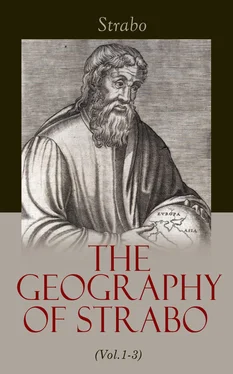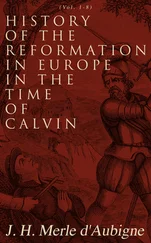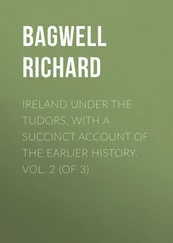Strabo - The Geography of Strabo (Vol.1-3)
Здесь есть возможность читать онлайн «Strabo - The Geography of Strabo (Vol.1-3)» — ознакомительный отрывок электронной книги совершенно бесплатно, а после прочтения отрывка купить полную версию. В некоторых случаях можно слушать аудио, скачать через торрент в формате fb2 и присутствует краткое содержание. Жанр: unrecognised, на английском языке. Описание произведения, (предисловие) а так же отзывы посетителей доступны на портале библиотеки ЛибКат.
- Название:The Geography of Strabo (Vol.1-3)
- Автор:
- Жанр:
- Год:неизвестен
- ISBN:нет данных
- Рейтинг книги:3 / 5. Голосов: 1
-
Избранное:Добавить в избранное
- Отзывы:
-
Ваша оценка:
- 60
- 1
- 2
- 3
- 4
- 5
The Geography of Strabo (Vol.1-3): краткое содержание, описание и аннотация
Предлагаем к чтению аннотацию, описание, краткое содержание или предисловие (зависит от того, что написал сам автор книги «The Geography of Strabo (Vol.1-3)»). Если вы не нашли необходимую информацию о книге — напишите в комментариях, мы постараемся отыскать её.
The Geography of Strabo (Vol.1-3) — читать онлайн ознакомительный отрывок
Ниже представлен текст книги, разбитый по страницам. Система сохранения места последней прочитанной страницы, позволяет с удобством читать онлайн бесплатно книгу «The Geography of Strabo (Vol.1-3)», без необходимости каждый раз заново искать на чём Вы остановились. Поставьте закладку, и сможете в любой момент перейти на страницу, на которой закончили чтение.
Интервал:
Закладка:
8. Opitergium, 1620Concordia, Atria, 1621Vicetia, 1622as well as some smaller cities, are less annoyed by the marshes: they communicate by small navigable canals with the sea. They say that Atria was formerly a famous city, from which the Adriatic Gulf, with a slight variation, received its name. Aquileia, which is the nearest to the head [of the gulf], was founded by the Romans, 1623to keep in check the barbarians dwelling higher up. You may navigate transport ships to it up the river Natisone for more than sixty stadia. This is the trading city with the nations of Illyrians who dwell round the Danube. Some deal in marine merchandise, and carry in waggons wine in wooden casks and oil, and others exchange slaves, cattle, and hides. Aquileia is without the limits of the Heneti, their country being bounded by a river which flows from the mountains of the Alps, and is navigable for a distance of 1200 stadia, as far as the city of Noreia, 1624near to where Cnæus Carbo was defeated in his attack upon the Kimbrians. 1625This place contains fine stations for gold washing and iron-works. At the very head of the Adriatic is the Timavum, 1626a temple consecrated to Diomede, worthy of notice. For it contains a harbour and a fine grove, with seven springs of fresh water, which fall into the sea in a broad, deep river. 1627Polybius, however, says that, with the exception of one, they are all salt springs, and that it is on this account the place is called by the inhabitants— the source and mother of the sea . Posidonius, on the other hand, tells us that the river Timavo, after flowing from the mountains, precipitates itself into a chasm, [Pg 320] [CAS. 215] and after flowing under ground about 130 stadia, discharges itself into the sea.
9. That Diomedes did hold sovereignty over the country around this sea, 1628is proved both by the Diomedean islands, 1629and the traditions concerning the Daunii and Argos-Hippium. 1630Of these we shall narrate as much as may be serviceable to history, and shall leave alone the numerous falsehoods and myths; such, for instance, as those concerning Phaethon and the Heliades 1631changed into alders near the [river] Eridanus, which exists no where, although said to be near the Po; 1632of the islands Electrides, opposite the mouths of the Po, and the Meleagrides, 1633found in them; none of which things exist in these localities. 1634However, some have narrated that honours are paid to Diomedes amongst the Heneti, and that they sacrifice to him a white horse; two groves are likewise pointed out, one [sacred] to the Argian Juno, and the other to the Ætolian Diana. They have too, as we might expect, fictions concerning these groves; for instance, that the wild beasts in them grow tame, that the deer herd with wolves, and they suffer men to approach and stroke them; and that when pursued by dogs, as soon as they have reached these groves, the dogs no longer pursue them. They say, too, that a certain person, well known for the facility with which he offered himself as a pledge for others, being bantered on this subject by some hunters who came up with him having a wolf in leash, they said in jest, that if he would become pledge for the wolf and pay for the damage he might do, they would loose the bonds. To this the man consented, and they let loose the wolf, who gave chase to a herd of horses unbranded, and drove them into the stable of the person who had become pledge for him. The man accepted the gift, branded the horses with [the representation of] a wolf, and named them Lucophori . They were distinguished rather for their swiftness than gracefulness. His heirs kept the same brand and the same name for this race of horses, and made it a rule never to part with a single mare, in order that they might remain sole possessors of the race which became famous. At the present day, however, as we have before remarked, this [rage for] horse-breeding has entirely ceased.
After the Timavum 1635comes the sea-coast of Istria as far as Pola, which appertains to Italy. Between [the two] is the fortress of Tergeste, distant from Aquileia 180 stadia. Pola is situated in a gulf forming a kind of port, and containing some small islands, 1636fruitful, and with good harbours. This city was anciently founded by the Colchians sent after Medea, who not being able to fulfil their mission, condemned themselves to exile. As Callimachus says,
“It a Greek would call
The town of Fugitives, but in their tongue
’Tis Pola named.”
The different parts of Transpadana are inhabited by the Heneti and the Istrii as far as Pola; above the Heneti, by the Carni, the Cenomani, the Medoaci, and the Symbri. 1637These nations were formerly at enmity with the Romans, but the Cenomani and Heneti allied themselves with that nation, both prior to the expedition of Hannibal, when they waged war with the Boii and Symbrii,(3) and also after that time.
10. Cispadana comprehends all that country enclosed between [Pg 322]
[CAS. 216] the Apennines and the Alps as far as Genoa and Vada-Sabbatorum. 1638The greater part was inhabited by the Boii, the Ligurians, the Senones, and Gæsatæ; but after the depopulation of the Boii, and the destruction of the Gæsatæ and Senones, the Ligurian tribes and the Roman colonies alone remained. The nation of the Ombrici 1639and certain of the Tyrrheni are also mixed amongst the Romans. These two nations, before the aggrandizement of the Romans, had some disputes with each other concerning precedence. Having only the river Tiber between, it was easy to commence war upon each other; and if the one sent out an expedition against any nation, it was the ambition of the other to enter the same country with an equal force. Thus, the Tyrrheni, having organized a successful expedition against the barbarians [dwelling in the countries] about the Po, but having speedily lost again through their luxury [all they had acquired], the Ombrici made war upon those who had driven them out. Disputes arose between the Tyrrheni and Ombrici concerning the right of possessing these places, and both nations founded many colonies; those, however, of the Ombrici were most numerous, as they were nearest to the spot. When the Romans gained the dominion, they sent out colonies to different parts, but preserved those which had been formerly planted by their predecessors. And although now they are all Romans, they are not the less distinguished, some by the names of Ombri and Tyrrheni, others by those of Heneti, Ligurians, and Insubri.
11. Both in Cispadana and around the Po there are some fine cities. Placentia 1640and Cremona, situated about the middle of the country, are close to each other. Between these and Ariminum, 1641are Parma, Mutina, 1642and Bononia, 1643which is near to Ravenna; amongst these are smaller cities on the route to Rome, as Acara, 1644Rhegium-Lepidum, 1645Macri-Campi, 1646where a public festival is held every year, Claterna, 1647Forum-Cornelium; 1648while Faventia 1649and Cæsena, situated near to the river Savio 1650and the Rubicon, 1651are adjacent to Ariminum. Ariminum, like Ravenna, is an ancient colony of the Ombri, but both of them have received also Roman colonies. Ariminum has a port and a river 1652of the same name as itself. From Placentia to Ariminum there are 1300 stadia. About 36 miles above Placentia, towards the boundaries of the kingdom of Cottius, is the city of Ticinum, 1653by which flows a river 1654bearing the same name, which falls into the Po, while a little out of the route are Clastidium, 1655Derthon, 1656and Aquæ-Statiellæ. 1657But the direct route as far as Ocelum, 1658along the Po and the Doria Riparia, 1659is full of precipices, intersected by numerous other rivers, one of which is the Durance, 1660and is about 160 miles long. Here commence the Alpine mountains and Keltica. 1661Near to the mountains above Luna is the city of Lucca. Some [of the people of this part of Italy] dwell in villages, nevertheless it is well populated, and furnishes the greater part of the military force, and of equites, of whom the senate is partly composed. Derthon is a considerable city, situated about half way on the road from Genoa to Placentia, which are distant 400 stadia from each other. Aquæ-Statiellæ is on the same route. That from Placentia to Ariminum we have already described, but the sail to Ravenna down the Po requires two days and nights. A 1662great part of Cispadana likewise was covered by marshes, through which Hannibal passed with difficulty on his march into Tyrrhenia. 1663But Scaurus drained the plains by navigable canals from the Po 1664to the country of the Parmesans. For the Trebia meeting the Po near Placentia, and having previously received many other rivers, is over-swollen near this place. I allude to the Scaurus 1665who also made the Æmilian road through Pisa and Luna as far as Sabbatorum, and thence through Derthon. There is another Æmilian road, which continues the Flaminian. For Marcus Lepidus and Caius Flaminius being colleagues in the consulship, and having vanquished the Ligurians, the one made the Via Flaminia from Rome across [Pg 324] [CAS. 218] Tyrrhenia and Ombrica as far as the territory of Ariminum, 1666the other, the road as far as Bononia, 1667and thence to Aquileia 1668by the roots of the Alps, and encircling the marshes. The boundaries which separate from the rest of Italy this country, which we designate Citerior Keltica, 1669were marked by the Apennine mountains above Tyrrhenia and the river Esino, 1670and afterwards by the Rubicon. 1671Both these rivers fall into the Adriatic.
Читать дальшеИнтервал:
Закладка:
Похожие книги на «The Geography of Strabo (Vol.1-3)»
Представляем Вашему вниманию похожие книги на «The Geography of Strabo (Vol.1-3)» списком для выбора. Мы отобрали схожую по названию и смыслу литературу в надежде предоставить читателям больше вариантов отыскать новые, интересные, ещё непрочитанные произведения.
Обсуждение, отзывы о книге «The Geography of Strabo (Vol.1-3)» и просто собственные мнения читателей. Оставьте ваши комментарии, напишите, что Вы думаете о произведении, его смысле или главных героях. Укажите что конкретно понравилось, а что нет, и почему Вы так считаете.












![Anne Blunt - A Pilgrimage to Nejd, the Cradle of the Arab Race. Vol. 2 [of 2]](/books/750183/anne-blunt-a-pilgrimage-to-nejd-the-cradle-of-the-thumb.webp)